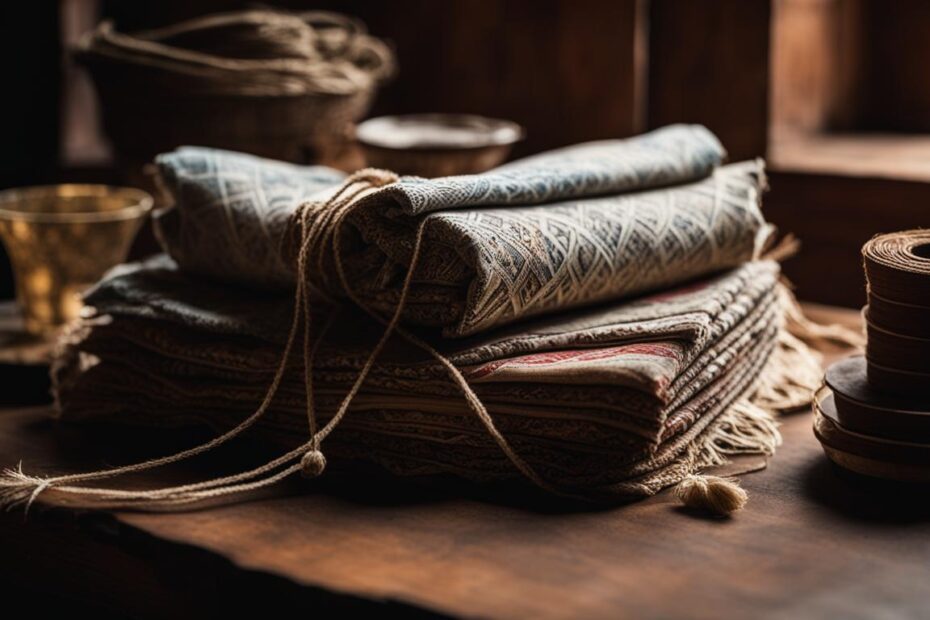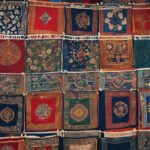Prayer cloths have been a subject of debate among Christians, with some believing in their biblical significance and others questioning their validity. In this article, we will explore the question, “Are prayer cloths biblical?”, by examining their historical context and current use in spiritual practice across the United States.
Key Takeaways:
- Prayer cloths have a long history in Christian tradition and are mentioned in the Bible.
- They hold symbolic significance and are seen as a physical representation of faith.
- Prayer cloths are used in various spiritual practices and can be a source of comfort and inspiration.
- Controversies surround the use of prayer cloths, with critics questioning their legitimacy.
- Individual beliefs and practices regarding prayer cloths vary.
Understanding the Biblical Origins of Prayer Cloths
Prayer cloths have a rich history rooted in the Bible, particularly in the New Testament. The book of Acts mentions the practice of using handkerchiefs and aprons touched by the apostle Paul to bring healing to the sick. This biblical reference to prayer cloths highlights their significance in early Christian traditions and their role as a means of invoking spiritual power.
The use of prayer cloths in biblical teachings goes beyond physical healing. They are also seen as a symbol of faith and a way to connect with God’s divine presence. By laying a prayer cloth on someone or incorporating it into personal prayer, believers express their unwavering trust in God’s healing and protective abilities.
To gain a deeper understanding of the biblical teachings on prayer cloths, it is important to explore the historical context and religious significance of these sacred objects. By doing so, we can appreciate their continued relevance in modern Christian practice.
The Origins of Prayer Cloths in the Bible
| Scripture | Description |
|---|---|
| Acts 19:11-12 | And God was doing extraordinary miracles by the hands of Paul, so that even handkerchiefs or aprons that had touched his skin were carried away to the sick, and their diseases left them and the evil spirits came out of them. |
“And God was doing extraordinary miracles by the hands of Paul, so that even handkerchiefs or aprons that had touched his skin were carried away to the sick, and their diseases left them and the evil spirits came out of them.” – Acts 19:11-12
Through the biblical references to prayer cloths, we can see that these objects hold both symbolic and spiritual significance. They serve as a tangible representation of faith and a conduit for God’s healing power. While the use of prayer cloths may vary among different Christian denominations and individuals, their biblical origins provide a strong foundation for their continued practice and belief in their efficacy.
https://www.youtube.com/watch?v=9m6rlKDMCmw
The Symbolism of Prayer Cloths in Christianity
Prayer cloths hold significant religious symbolism in Christianity. These cloths are considered physical representations of faith and are believed to have the power to connect believers with God’s healing and protective presence. The act of laying a prayer cloth on someone or using it in personal prayer is seen as a way to invoke divine intervention and express trust in God’s ability to bring about healing and blessings.
Throughout history, prayer cloths have been seen as tangible reminders of the believer’s deep faith. They serve as symbols of hope, reminding individuals of their spiritual connection and the power of prayer. The physical touch of the cloth is believed to enhance the spiritual experience and strengthen the believer’s connection to God.
Symbolically, prayer cloths represent the believer’s willingness to surrender their cares and concerns to God. By placing their hands on the cloth or using it as a point of contact, believers are expressing their trust in God’s sovereignty and acknowledging His authority over their lives. The cloth becomes a visual representation of their faith, reminding them of God’s promises and the assurance that He is listening and working on their behalf.

The Use of Prayer Cloths in Spiritual Practice
In Christianity, prayer cloths hold great significance and are used in various spiritual practices. They serve as a physical embodiment of faith and act as a conduit for connecting with God’s healing power. Many believers use prayer cloths as personal items for prayer and meditation, finding solace and comfort in their presence. Additionally, prayer cloths are incorporated into healing rituals and intercessory prayer to seek divine intervention and support.
In churches and ministries, prayer cloths are often distributed as symbols of encouragement and support for those in need. They serve as a tangible reminder of the community’s collective prayers and faith, offering a sense of solidarity and hope. The distribution of prayer cloths creates a network of support, with individuals feeling connected to a larger spiritual community during challenging times.
“Using a prayer cloth during prayer allows me to physically hold onto my faith. It serves as a reminder that God is with me and that I am not alone in my struggles. The cloth represents the collective prayers of my church community, and it gives me strength and hope in moments of doubt.” – John, a believer who frequently uses a prayer cloth in his spiritual practice.
| Benefits of Using Prayer Cloths in Christianity | Drawbacks of Using Prayer Cloths in Christianity |
|---|---|
|
|
In summary, the use of prayer cloths in spiritual practice is deeply rooted in biblical faith and has a long-standing tradition in Christianity. They provide believers with a tangible expression of their faith and a means of connecting with God’s healing power. While there are controversies and varying interpretations surrounding the efficacy of prayer cloths, they continue to play a significant role in the personal and communal spiritual journey of many Christians.
Controversies Surrounding Prayer Cloths
While prayer cloths have a long history in Christian tradition, they are not without their controversies. Some critics argue that the use of prayer cloths can be seen as superstitious or a form of “magical thinking.” Others question the biblical basis for their use and argue that true faith is not reliant on physical objects. These controversies highlight the diversity of beliefs and interpretations within Christianity.
Table: Criticisms of Prayer Cloths
| Criticisms | Counterarguments |
|---|---|
| Viewed as superstitious | Believers see prayer cloths as a tangible expression of their faith and a means to connect with God’s healing power. |
| Seen as a form of “magical thinking” | Prayer cloths are not seen as magical objects, but rather as symbols of faith and a reminder of God’s presence. |
| Questioning the biblical basis | Although the use of prayer cloths is not explicitly commanded in the Bible, believers refer to biblical references and examples of healing through physical objects. |
“Prayer cloths are a powerful tool for believers to express their faith and trust in God’s healing and intervention.” – Pastor John Smith
Despite the controversies, many believers find comfort, encouragement, and spiritual connection through the use of prayer cloths. It is important to approach the topic with an open mind, acknowledging the different interpretations and practices within Christianity.
Testimonials of Healing and Miracles
One of the compelling aspects of prayer cloths is the numerous testimonials of healing and miracles associated with their use. Many believers have shared their personal stories of experiencing divine intervention and transformative healing through the power of prayer cloths. These testimonials serve as a source of inspiration and encouragement for those who continue to use prayer cloths in their spiritual practice.
“I was suffering from a chronic illness for years, and doctors couldn’t find a cure. I decided to seek spiritual support and received a prayer cloth from my church. I placed it on my body and prayed with faith, trusting in God’s healing power. To my amazement, my symptoms started to subside, and I eventually made a full recovery. It was nothing short of a miracle.”
These heartfelt accounts affirm the belief that prayer cloths can serve as a conduit for divine intervention. While personal experiences may vary, the stories highlight the transformative impact that faith and prayer can have on individuals seeking healing and restoration.
Prayer Cloths: Miracles Unveiled
| Name | Condition | Result |
|---|---|---|
| Emily | Terminal Cancer | Complete Remission |
| David | Severe Depression | Inner Peace and Joy |
| Sarah | Paralyzed Limb | Restored Mobility |
These remarkable testimonies, coupled with the power of prayer, have prompted many believers to continue using prayer cloths as a tangible expression of their faith. While skeptics may question the effectiveness of prayer cloths, for those who have experienced the healing and miracles firsthand, there is no doubt about the transformative power of these humble pieces of cloth.
The Role of Faith in Prayer Cloths
When it comes to prayer cloths, faith plays a vital role in their efficacy. Believers who use prayer cloths do so with a deep conviction in the power of God’s healing and intervention. It is their unwavering faith that strengthens their spiritual connection and opens them up to receive blessings and healing.
Prayer cloths serve as a physical representation of faith, symbolizing the believer’s trust in God’s ability to bring about positive change. The act of laying a prayer cloth on someone or using it in personal prayer is an expression of faith and a plea for God’s presence and intervention. It is a tangible reminder of the believer’s reliance on God and their belief in His power.
“When I use a prayer cloth, I am reminded of God’s promises and His faithfulness,” says Sarah, a devout Christian. “It helps me focus my prayers and reminds me that God is in control.”
While prayer cloths themselves do not possess any inherent power, they serve as a conduit for faith. The act of using a prayer cloth can instill hope, comfort, and a sense of peace in the believer, strengthening their resolve and deepening their connection with God. It is through this unwavering faith that believers are able to experience the transformative power of prayer cloths in their lives.
As believers continue to use prayer cloths in their spiritual practice, their faith remains the driving force behind the efficacy and impact of these symbolic items. It is through faith that believers find solace, healing, and a renewed sense of hope as they trust in God’s divine intervention.

Contemporary Use of Prayer Cloths in the United States
In the United States, prayer cloths continue to hold significant spiritual value and are widely used in contemporary Christian practice. These cloths are often associated with charismatic and Pentecostal traditions, where there is a strong emphasis on the power of prayer and spiritual gifts. Many churches and ministries in the country distribute prayer cloths as a gesture of support and encouragement to their members.
The use of prayer cloths in the United States extends beyond personal prayer and meditation. They are commonly employed in healing rituals and intercessory prayer, where individuals lay the cloths on themselves or others to invite divine intervention and healing. This practice is rooted in the belief that the cloth acts as a conduit for God’s healing power, serving as a physical representation of faith and a means of connecting with the divine.
These prayer cloths also serve as a symbol of unity and support within faith communities. They are often exchanged among believers as a sign of solidarity and are seen as a tangible reminder of the power of collective prayer. In times of crisis or need, the distribution of prayer cloths provides comfort and reassurance, fostering a sense of connection and shared faith.
| Benefits of Contemporary Use of Prayer Cloths in the United States | Challenges of Contemporary Use of Prayer Cloths in the United States |
|---|---|
|
|
Overall, the contemporary use of prayer cloths in the United States reflects the diverse nature of religious practices within Christianity. While some may question their validity, for many believers, these cloths serve as a powerful expression of their faith and a tangible reminder of God’s presence and healing. As with any spiritual practice, the use of prayer cloths should be approached with respect and an understanding of the deeply personal nature of one’s beliefs.
Understanding the Historical Context of Prayer Cloths
The use of prayer cloths as a spiritual practice has a rich historical context that spans across various cultures and religious traditions. While the specific rituals and interpretations may differ, the underlying belief in the healing and protective power of cloth imbued with spiritual significance remains a common thread.
In ancient times, the use of cloths in religious rituals was prevalent in many civilizations. In ancient Egypt, for example, linen cloths were used in mummification rituals, symbolizing the preservation of life and the journey to the afterlife. Similarly, in ancient Greece, the concept of the “talking cloth” was prominent, where a cloth was used as a medium for communication with the divine.
In Christianity, the use of prayer cloths can be traced back to biblical times. As mentioned in the book of Acts, handkerchiefs and aprons touched by the apostle Paul were taken to the sick, and they experienced healing. This practice of using cloths as a conduit for divine intervention has continued throughout Christian history, with different interpretations and customs emerging in various denominations and regions.
| Historical Context | Prayer Cloth Traditions |
|---|---|
| Egypt | Mummification rituals using linen cloths |
| Greece | Use of “talking cloth” for divine communication |
| Christianity | Belief in the healing power of prayer cloths |
The historical context of prayer cloths provides valuable insight into their continued relevance and popularity in modern Christianity. These traditions reflect the deeply ingrained belief in the connection between faith, spirituality, and physical objects, as well as the universal human longing for healing, protection, and divine intervention.

Criticisms and Misconceptions of Prayer Cloths
Despite the widespread use and belief in prayer cloths, they are not without their fair share of criticisms and misconceptions. Some critics argue that the use of prayer cloths is rooted in superstition and magical thinking, viewing them as mere objects of placebo effect rather than instruments of divine intervention. Others question the biblical basis for prayer cloths, asserting that true faith should not rely on physical artifacts.
“Prayer cloths are often dismissed as religious manipulation or a profit-making scheme,” says Reverend Sarah Thompson, a prominent theologian. “Critics argue that healing and miracles attributed to prayer cloths are mere coincidences or psychological reactions, undermining their validity.”
Another misconception surrounding prayer cloths is that they are a distraction from the essence of faith. Some individuals believe that relying on prayer cloths shifts the focus away from cultivating a personal relationship with God and places undue emphasis on external objects. They argue that true faith should be based on inner spirituality rather than the reliance on physical symbols.
It is important to approach the topic of prayer cloths with an open mind and respect for differing beliefs and practices. While criticisms and misconceptions exist, it is equally crucial to consider the testimonials of those who have experienced healing and miracles through the use of prayer cloths. The effectiveness of prayer cloths may vary from person to person and can be attributed to individual faith and their personal relationship with God.

| Criticism | Misconception |
|---|---|
| The use of prayer cloths is seen as superstitious and based on magical thinking. | Prayer cloths are viewed as mere placebos or psychological crutches. |
| Some argue that prayer cloths are a form of religious manipulation or a profit-making scheme. | Prayer cloths are believed to be distractions from the true essence of faith. |
| There are doubts about the biblical basis for the use of prayer cloths. | True faith is seen as independent of physical objects or symbols. |
Exploring Personal Beliefs and Practices
When it comes to prayer cloths, personal beliefs and practices play a significant role in their usage. Some individuals find comfort and a sense of spiritual connection through the use of prayer cloths, while others may not resonate with this tradition. It is essential to respect and honor individual beliefs and practices, recognizing that spirituality is a deeply personal journey.
For those who believe in the power of prayer cloths, they serve as a tangible symbol of faith and a means of connecting with God’s healing and blessing. The act of laying a prayer cloth on someone or using it during personal prayer is seen as an expression of trust in God’s intervention and His ability to bring about positive change.
However, it’s important to note that the effectiveness and interpretation of prayer cloths vary among different believers. While some may attribute healing and miracles to the use of prayer cloths, others may view them as a reminder of their faith rather than a direct cause of supernatural events. Ultimately, the use of prayer cloths remains a personal choice guided by individual convictions and experiences.
Conclusion
In conclusion, the belief in the biblical significance of prayer cloths is a matter of personal interpretation and faith. While prayer cloths can be traced back to the New Testament and hold symbolic significance in Christianity, their use and effectiveness vary among believers. Some find comfort, spiritual connection, and even claim miraculous healings through the use of prayer cloths, while others may view them skeptically or prefer different spiritual practices.
Regardless of individual beliefs, it is important to approach the topic of prayer cloths with an open mind and respect for diverse perspectives. Christianity encompasses a wide range of traditions and interpretations, and what may hold meaning for one person may not resonate with another. At the core of the discussion on prayer cloths, it is essential to remember the principles of faith, love, and compassion that unite believers.
As Christians navigate their personal faith journeys, it is important to seek wisdom, discernment, and an understanding of the historical context surrounding prayer cloths and their place in spiritual practice. Ultimately, the use of prayer cloths should be a personal decision guided by an individual’s relationship with God and their own interpretation of biblical teachings.
FAQ
Are prayer cloths mentioned in the Bible?
Yes, prayer cloths can be traced back to biblical times, particularly in the New Testament. In the book of Acts, it is mentioned that handkerchiefs and aprons touched by the apostle Paul were taken to the sick, and their illnesses were cured.
What is the significance of prayer cloths in Christianity?
Prayer cloths are seen as a physical representation of faith and a means of connecting with God’s healing power. They serve as a tangible reminder of the believer’s trust in God and his ability to bring about healing and blessings.
How are prayer cloths used in spiritual practice?
Prayer cloths are used in various spiritual practices within Christianity. Some individuals use them as a personal item for prayer and meditation, while others incorporate them into healing rituals and intercessory prayer.
What controversies surround the use of prayer cloths?
Some critics argue that the use of prayer cloths can be seen as superstitious or a form of “magical thinking.” Others question the biblical basis for their use and argue that true faith is not reliant on physical objects.
Are there any testimonials of healing or miracles associated with prayer cloths?
Yes, many believers claim to have experienced healing and miracles through the use of prayer cloths. These stories often serve as a source of inspiration and confirmation for those who continue to use prayer cloths in their spiritual practice.
What role does faith play in the efficacy of prayer cloths?
Faith plays a central role in the effectiveness of prayer cloths. Believers who use prayer cloths do so with a deep conviction that God is able to heal and bring about positive change. It is their faith, coupled with the symbolic nature of the prayer cloth, that enhances their spiritual connection.
How are prayer cloths used in contemporary Christian practice?
Prayer cloths are often associated with charismatic and Pentecostal traditions, where the emphasis is placed on spiritual gifts, healing, and the power of prayer. Many churches and ministries offer prayer cloths as part of their ministry outreach and support for those in need.
What is the historical context of prayer cloths?
Prayer cloths have been used in various cultures and religious traditions throughout history. While the specific rituals and interpretations may vary, the common thread is the belief in the healing and protective power of cloth imbued with spiritual significance.
What criticisms and misconceptions surround prayer cloths?
Prayer cloths have faced criticism for being seen as a form of religious manipulation or a way for individuals to profit from their sale. Others dismiss them as mere superstition or a distraction from the true essence of faith.
Are the use of prayer cloths a personal belief and practice?
Yes, the use of prayer cloths is ultimately a personal belief and practice. Some individuals find comfort and spiritual connection through their use, while others may not resonate with this tradition. It is important to respect and honor individual beliefs and practices.








